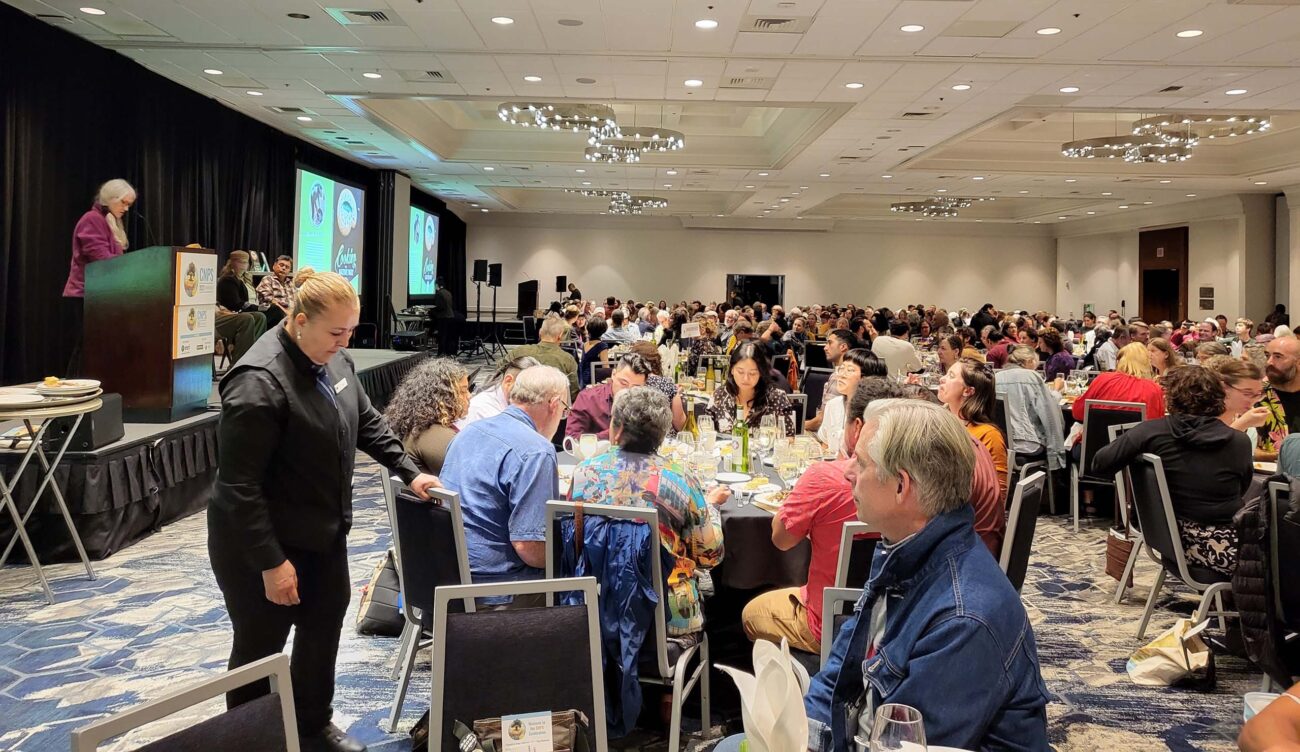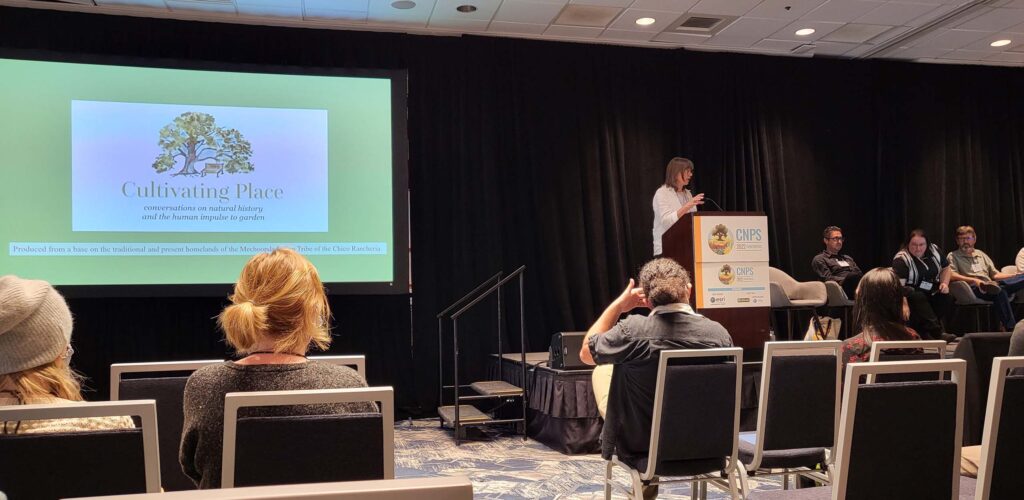
The CNPS 2022 Conference took place at DoubleTree by Hilton Hotel San Jose during the third week of October. Due to the COVID-19 pandemic, the last CNPS “triennial” conference was four years ago. “This year’s theme—Rooting Together: Restoring Connections to Plants, Place, and People—is a reminder that,” as Robin Wall Kimmerer, author of Braiding Sweetgrass: Indigenous Wisdom, Scientific Knowledge and the Teachings of Plants, wrote, “the relationship between self and the world is reciprocal. We learn from one another, we inspire each other, and we must meet challenges together.”
I will offer highlights of my Conference experience with a few take-home points from the presenters, but you can make your own experiences when CNPS publishes some of the Conference recordings. The Conference emphasized that increased biodiversity and diversity of voices representing native plants are effective mechanisms for dealing with the challenges of climate change, species extinction, development pressure, and the ongoing legacy of colonialism. Native Americans spoke throughout the Conference. Marcella Luna, Steward and Amah Mutsun Tribal Band Council Member, said of a tribal perspective, “Our ancestors took care of the lands and Mother Earth, and it is important for us to continue that . . . to get involved with stewardship. It’s a spiritual connection with the land, the animals, with yourself, with others.”
Oaks and Oak Woodlands Session
The Oaks and Oak Woodlands Session was one of the most popular sessions. Historically, since 1849, oaks and oak woodlands have been under threat from development and fire suppression, and the threat continues today from disease, drought, invasive species, wildfire, and a changing climate. Strategies for conserving, stabilizing, and regenerating critical oak woodland ecosystems were discussed.
A re-oaking (oak restoration) project for Quercus lobata in the Bay Area focused on the following key features of oak woodland ecosystems essential for biodiversity and ecological function: protection of large oak trees in nodes of multiple large oak trees; protection of oak corridors between nodes; and protection of native understory vegetation of forbs, grasses, and shrubs, along with downed logs, leaf litter, and water sources.
Other talks in this session concluded that there is a close interrelationship between oaks and biodiversity, and ectomycorrhizal fungi from warmer, drier climates may improve oak restoration results. The heat-adapted microbial community may improve the stress tolerance of oaks during our climate crisis.
For those of us in the Wildland–Urban Interface and involved in the Carr Fire, the “Principles and Best Practices for Fire Fuel Reduction in California Oak Woodland” talk was most salient. The best management practices of forest thinning and shaded fuel breaks include the following goals: (1) <8-inch standing dead material dropped and bucked to 4- x 4-foot piles; (2) 4- x 4-foot piles placed on even slopes, spread a safe distance apart and away from drip lines of living trees; (3) dead branches and limbs trimmed up to a minimum of 10 feet from the ground; (4) >8-inch trees left standing as snags for habitat; (5) downed material >8 inches dropped to make ground contact and left in large sections to increase decomposition and slow erosion; (6) isolated living firs greater than >12 inches and found within hardwood stands selectively girdled. Douglas-firs are not fire resistant, according to Jason M. Mills (WRA Landscape Restoration).
Chaparral Resilience and Future Concerns Session
From the Conference program on this session: “Chaparral contains 24 percent of California’s native plant species, and more of these plants are considered rare here than in any other plant community. Since chaparral exists in every single county, chaparral represents the most accessible native plant experience to the greatest number of Californians and visitors to our state, and it provides unique research and educational opportunities. Due to the uniqueness of chaparral, it presents major challenges to fire managers concerned with balancing fire hazard reduction and resource conservation.”
Chaparral in general is a biodiverse ecosystem that is highly adapted to fire. However, anthropogenic alteration of the historical fire regime has led to increased fire frequency and severity and has put this ecosystem at risk of type conversion. What is the tipping point at which shrub regeneration drops off, and non-native, highly flammable grasses become the dominant herbaceous species? These grasses would increase the probability of fire ignition and spread fire more easily than shrubs. How much time is needed between fires for the recovery of chaparral? Jon Keeley, from US Geological Survey and UCLA, said, “Throughout the state, obligate-seeding shrubs appear to be at risk due to intervals between fires previously thought to be safe.” The soil seed bank takes time to replenish, especially in times of drought. Some talks indicated 15- to 17-year intervals as the threshold point, but others said 7 to 8 years. This is important information for prescribed burns in chaparral. A combination of wildfires and prescribed burns could decrease the fire interval and subsequently increase the chance of a type conversion from chaparral to grasslands. More research is needed.
Horticultural Considerations in the Face of Climate Change Session
This session successfully delivered practical information on critical issues facing California gardeners. Greg Rubin, a landscape designer from Escondido, started off the session with, “Protecting the Wildland–Urban Interface in California from Wildfire Threats to Homes.” He gave essentially the same talk in August 2022 during the CNPS Naturehood Gardening Series, Native Gardening 101: Firescaping. His research with the US Navy studied native chaparral and sage scrub shrubs in the San Diego area. He discussed the concept of live fuel moisture content and the relationship with predicting fire behavior. He concluded, “Lightly irrigated native shrubs planted around homes can reduce fire hazard . . .” He is an interesting speaker because many of his ideas are contrarian, but he backs up his recommendations with science and common sense. He concluded that light, summer and fall hydration of native plants can reduce the fire hazard and is more important than a firewise plant list.
Lindsey Stuvick (Moulton Niguel Water District, Laguna Hills) gave an informative and inspirational talk from the water district perspective, “Emphasizing California Natives in a Water Utility’s Drought Resiliency Strategy.” I am comforted that some water districts “get it” and are leading the way. The District even offers a Turf-to-Native-Garden Program instant rebate of $4 per square foot! She said, “California natives have become an integral part of Moulton Niguel’s drought resilience strategy. The District has produced replicable and scalable water efficiency programs that can be adopted by other water agencies to build drought resilience in their own service areas.” All water district leaders should watch this recording when it becomes available.
Another speaker you should not miss is Scott Kleinrock (Chino Basin Water Conservation District, Montclair). His talk was, “Saying ‘Native’ Last: Promoting California Native Gardens to New Audiences during Drought and Defending Their Installation during Times of Watering Restrictions.” The following are a few take-home points: (1) neighbors are okay with native plant gardens if the landscape is intentional and cared for; (2) match wording to the audience: rather than “safeguarding biodiversity,” use “providing homes for songbirds, butterflies, and native, non-stinging pollinators who need our help and are a pleasure to see in our gardens;” and (3) stick to common names—using Latin names first does not generally work. I encourage you to catch his workshops on the Waterwise Community Center YouTube channel.
Native Plant Production and Sales Session
The Native Plant Production and Sales Session was a popular horticultural track session. The nursery empowering Bloom! California is the result of CNPS receiving a Specialty Crop Block Grant to build a campaign promoting specialty crop native plant gardening. Gardener-empowering Calscape is the envy of other states and is being updated with a more user-friendly platform and more, accurate information.
Kevin Alison (Tree of Life Nursery, San Juan Capistrano) talked about “Large-Scale Propagation of Ethically Grown Liveforevers (Dudleya spp.) to Prevent Poaching and Extinction.” Dudleya are considered “gateway” plants—a gateway to more native plants! He uses the advanced propagation method of plant tissue culture to ethically produce enormous numbers of select Dudleya species. This project should deflate the price incentive for poachers and provide an additional tool for horticulture and conservation.
Climate Change, Conservation Science, and Adaptive Management Session
This session included “Prioritizing California Native Plants for Butterfly and Moth Conservation.” Christopher T. Cosma and Nicole Rafferty (University of California, Riverside) developed an amazing beta website, The Butterfly Net: Lepidoptera Conservation Tool. The goal of the website is to find the best host and nectar plants for butterflies and moths anywhere in California. Fun fact—95% of Lepidoptera species are moths and 5% are butterflies. Monarch butterfly conservation and milkweed plantings are important, but Chris believes, “it is time for Lepidoptera conservation in the western US to move beyond this narrow focus on one species. Hundreds of other western US butterfly species are in decline, including some even more at risk of extinction than the monarch. Like the monarch, each species requires specific native plants to survive. [He] finds that relatively few plant species support the majority of Lepidoptera species, and Lepidoptera species use discrete host and nectar plants.” The following are a few take-home points: plant native host and nectar plants, prioritize the most important plants, and consider geographic variation in species and interactions. The loss of monarch nectar plants could contribute more to their decline than the loss of the milkweed host. Conservation efforts should consider resource dependencies at each life stage. Caterpillars are more specialized than adults; therefore, caterpillars are more sensitive to plant extinctions than adults. Forty-three percent of Lepidoptera species in California have just one host plant, and 73% have three or less. The identity of the top 10 plant species for Lepidoptera varies significantly between ecoregions and habitats.
Safety, Sanitation, Pathogens, and Pests Session
The Safety, Sanitation, Pathogens, and Pests Session has become a horticulture track keystone issue at CNPS conferences. Phytophthora (“the plant destroyer”), Phytophthora best management practices, and Phytophthora risk management are important topics, just as they were four years ago at the last conference: not much has changed in the past four years. Phytophthora species are still amongst the most highly damaging invasive plant pathogens in the world. What has changed are the limited resources of some nurseries. For example, the Golden Gate National Parks nurseries have limited resources for the extremely labor-intensive Phytophthora testing process, but assessing the effectiveness of their best management practices is still critical. Streamlining the testing required new testing criteria based on a plant’s risk factors. The pear-baiting process is still the gold standard. (My prognostication: environmental DNA (eDNA) analysis may broaden and include Phytophthora testing within the next decade.)
BIPOC Perspectives in Conservation Session
CNPS’s BIPOC (Black, Indigenous, and People of Color) Group came up with the BIPOC Perspectives in Conservation Session, in which BIPOC presenters could have a space to speak upon their experiences in the conservation community.
The session began with, “How to Decolonize in 12 Not-So-Easy Steps,” by Brenda Kyle (independent California naturalist and interpretive guide, Asuksangna). Brenda noted that, “Diversity in the workplace cannot happen until we decolonize our way of thinking. By using and adapting a 12-step recovery program, we can make strides to end our addiction to the status quo.” Colonization was defined as, “the action or process of settling among and establishing control over the indigenous people of an area.” Why were so many people looking at the few old, white guys who attended this session?
Julia Samaniego, a Native American, “met with several of [her] fellow Tribal Knowledge Keepers from the Fernandeno Tattaviam Village and Chumash Village to reveal the lost practices of agriculture science and cultural traditions that were once the foundation of [their] survival. Native plants have thrived for millions of years, yet their contributions remain largely elusive to contemporary society. Most Indigenous and Native American villages lack proper resources to pass down the basic teachings of even the most basic plant knowledge. [She] hopes to be able to connect other villages with their ancestors as well as teach [their] next generation of naturalists to never forget that we are all connected.”
Seeing the Forest for the Trees: Conservation in the Face of Timber Harvest and Fuel Management Session
This was the last session. Everyone’s goal is resilient forests, but where have we come from, what do we have, and where do we need to go? Northern California forests have endured 200 years of aggressive timber harvest and over 100 years of fire suppression. Dr. Clarke A. Knight (US Geological Survey, Menlo Park) integrated paleo- and ethnographic records as a way of understanding the ecology of the past (paleoecology), dating back over 3 millennia in the western Klamath Mountains. Traditional Ecological Knowledge from the Karuk-Yurok Tribes provided the ethnographic records. “A fire regime consisting of tribal burning practices and lightning were associated with long-term stability of forest biomass. Before Euro-American colonization, the long-term median forest biomass was between 104 and 128 Mg ha-1, compared to values over 250 Mg ha-1 today.” The following are her solutions to combating a closed Douglas-fir–dominant forest unlike any seen in the preceding 3,000 years: make larger scale interventions to achieve historical fidelity; temper expectations about carbon storage; engage with Tribes; and restore Native burning practices.
From Ryan Tompkins (University of California Cooperative Extension, Quincy): “Building on ecological theory and recent studies, we suggest that this historical forest structure promoted resilience by minimizing competition, which in turn supported vigorous tree growth and sustained large trees—the ‘backbone’ of these forested ecosystems . . . Between 1911 and 2011, tree densities on average increased six- to seven-fold, while average tree size was reduced by 50%.” Pine forests of 1911 have moved from the range of “low” competition to 2011 forests in the range of “full competition” and “imminent mortality.” Ryan continued, “With the contemporary increase in compounding stresses such as drought, bark beetles, and high-severity wildfire, resilience in frequent-fire forests may hinge on creating stands with significantly lower densities and minimal competition. Creating stands largely free of competition would require a fundamental rethinking of how frequent-fire forests can be managed for resilience.”
The session chair, Paul Mason (Pacific Forest Trust, Sacramento) said, “There needs to be more sawdust and more smoke.”
Restoration Seed Supply Expert Panel
This panel was not on the Conference hardcopy schedule, but it was on the Cvent Conference app. I was thrilled to find this discussion, because the panel of restoration ecologists, native seed suppliers, and governmental restorationists were quite candid. Essentially, the field of native plant restoration is challenged by sourcing appropriate plant materials, determining appropriate seed transfer zones, and the scaling and timing of native plant and seed production. There needs to be better communication and collaboration between the different stakeholder groups. The restoration seed suppliers often receive orders that are expected to be filled in weeks to months, but the reality is that it takes several years to produce the large amount of appropriate native seeds and plants for restorations. The seed production process is not cheap. When seed suppliers produce seed not initially tied to restoration projects, they are often left with expensive seed that is difficult to sell. The developing California Seed Strategy and the recently formed California Native Seed Supply Collaborative will hopefully improve the state of restoration seed supply in California.
CNPS Celebration Banquet and Fundraiser
The Chia Café Collective provided the keynote presentation at the sold-out CNPS Celebration Banquet and Fundraiser. We were introduced to the intersection of native foods, Indigenous culinary legacies, and a vision for a sustainable food-sovereign future. One of the speakers mentioned that, to make the food palatable to a wider audience, they blend the flavors of modern cuisine made from Southern California native plants with more traditional American ingredients. Many of the banquet courses included nopales (Opuntia or prickly-pear cactus), tepary beans, chia, and elderberry. I left the fundraiser early because I needed to catch the late-night mass-transit trolley, but by all reports, the fundraiser was wildly successful.
Closing Plenary
The Conference ended with the closing plenary talk by the Northstate’s very own Jennifer Jewell, host of the national award-winning weekly public radio program, Cultivating Place: Conversations on Natural History and the Human Impulse to Garden. Her keynote address anchored an expert panel discussion focusing on the importance of seed in our personal and cultural, gardening, environmental, and economic lives. This topic is also the genesis of her third book, by Timber Press, coming out in late 2023. She is always a captivating and inspirational speaker. When the recording comes out, settle in for a passionate, cerebral, and empowering discourse about seeds and gardening. ~Doug Mandel

